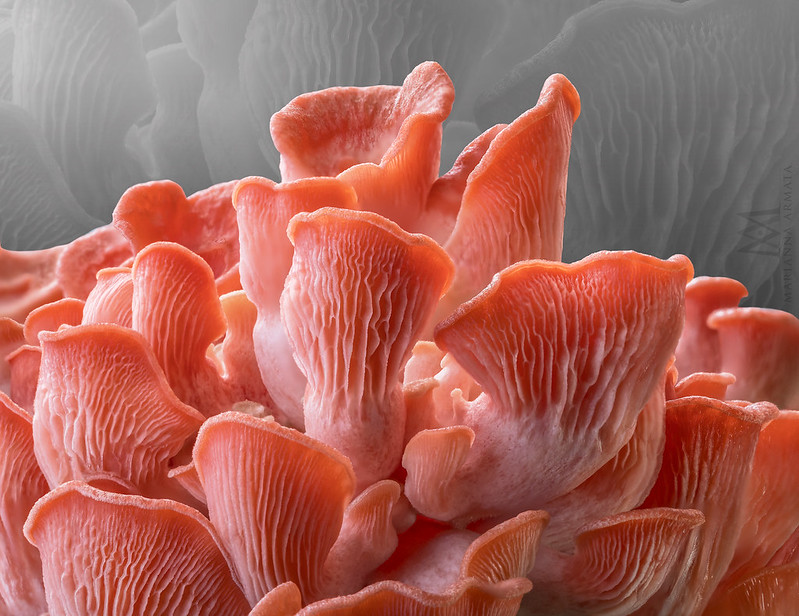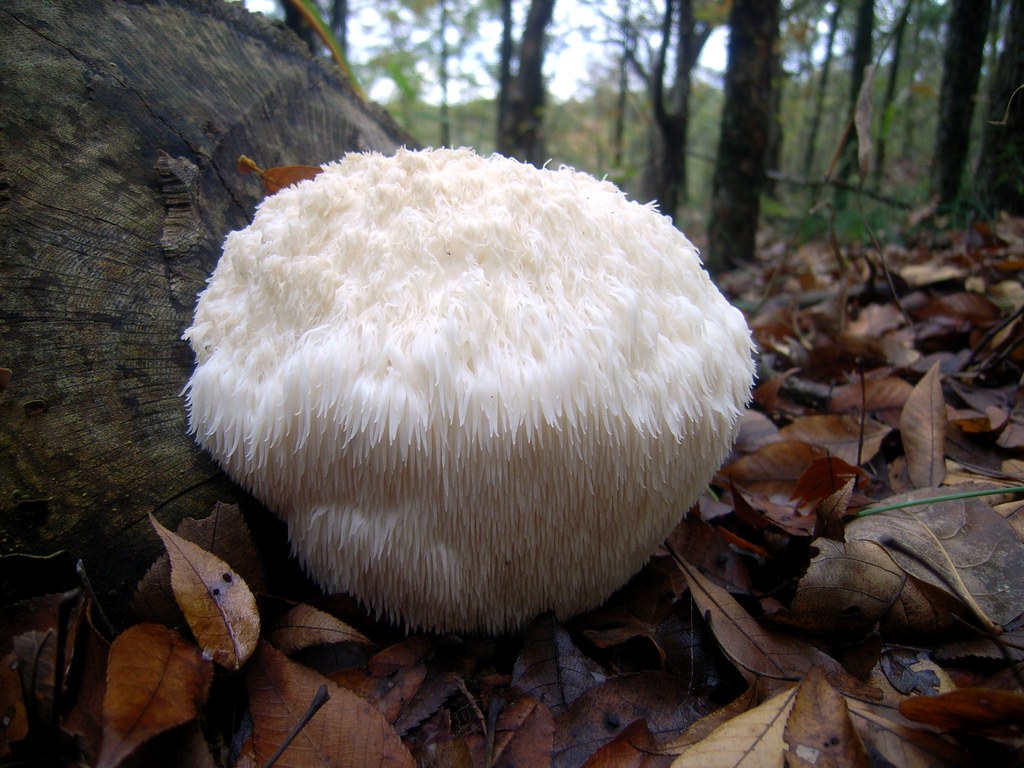Edible wood-loving mushrooms are more common than you might think. While the ubiquitous white button mushroom (and brown creminis and portobellos) are cultivated on composted manure, many edible varieties actually grow on wood. Oyster mushrooms, shiitakes, chicken-of-the-woods, chanterelles, wine caps, and many more choice edible mushrooms actually grow on wood.
For the new mushroom grower, wood-loving mushrooms are generally easier to grow (and you don’t have to deal with manure!) so there are many kits or spawn sources available.
I’ve grown several mushrooms at home, mostly from kits, including various types of oyster mushrooms, shiitakes, lion’s mane, and wine caps. In my experience, it can be tricky keeping ideal growing conditions, but some, like oyster and wine cap mushrooms, are the perfect first mushroom to grow at home. Below are 9 edible mushrooms that grow on wood and have ready-to-grow kits available for the home grower.
On this page:
Oyster Mushroom
One of the easiest mushrooms to grow; prolific producer with a mild, delicious taste
Species Name: Pleurotus ostreatus
Other Common Names: Pearl Oyster, Tree Oyster, White/Black/Blue/Brown Oyster (different-colored subspecies)
Flavor/Texture: Mild, mushroomy, woody; delicate texture
Growing Media: Hardwood (logs, sawdust, chips), straw, coffee grounds, grains, virtually any dried, woody/fibrous plant matter
Where to Grow: Outdoors (temperate climate) or indoors
Fruiting Temperature: 60-70°F (10-21°C)
Growing Difficulty: Very Easy
Biggest Challenge: Balancing humidity and fresh air to get larger oyster mushrooms
Where to Get Kits/Spawn: Back to the Roots (US), Park Seed (US), Cascadia Mushrooms (US), Field & Forest (US), GroCycle (UK), Gourmet Woodland Mushrooms (UK), WhatTheFungus (Canada), Grow Mushrooms Canada (Canada), Amazon (US, UK, Can)
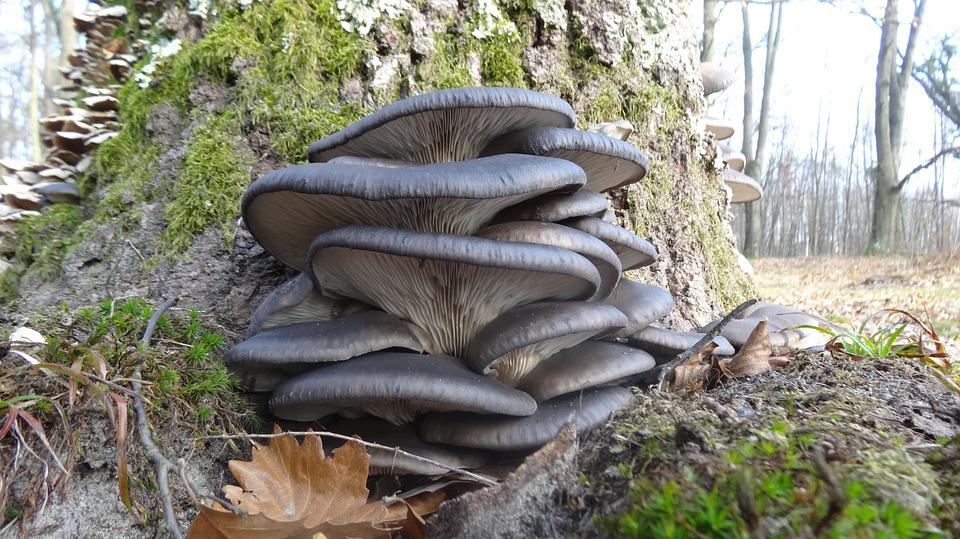
The most beginner-friendly wood-loving mushroom to grow at home is the oyster mushroom. It grows insanely fast, is not too picky about temperature, can thrive indoors or outdoors, can give you multiple flushes of mushrooms to harvest, and can gobble up almost any kind of woody plant material. Some people have even grown oyster mushrooms on cardboard, toilet paper rolls, and cotton clothing! Because oyster mushroom mycelium (the white, root-like part of a mushroom that spreads across the growing medium) grows so vigorously, it can sometimes compete with minor mold contamination.
Common strains come in different colors, mainly white/gray, black, blue, and brown. The color differences will be on the top of the cap, and the intensity of the color is based on how much light they receive.
The only challenge you may run into is ensuring the baby mushrooms (pins) can grow in an environment with high humidity and good air flow. Oyster mushrooms are quite sensitive to carbon dioxide and will produce skinny (but still edible) mushrooms without adequate fresh air flow.
Oyster Mushroom Grow Tips: It’s really hard to screw up growing oyster mushrooms, especially if using a kit. However, once you do start getting mushrooms, you will notice that mature oyster mushrooms produce spores profusely. Take care not to inhale the mushroom spores, especially if growing several oyster mushroom kits in the same room.
King Oyster Mushroom
A meaty mushroom ideal for the grill, with a classic mushroomy flavor in every toothy bite
Species Name: Pleurotus eryngii
Other Common Names: King Trumpet, French Horn, Boletus of the Steppes
Flavor/Texture: Mild, mushroomy; firm, meaty texture
Growing Media: Hardwood (logs, sawdust, chips), straw, coffee grounds, grains
Where to Grow: Outdoors (temperate climate) or indoors
Fruiting Temperature: 60-70°F (15-21°C); slightly cooler temperatures ideal to trigger fruiting
Growing Difficulty: Moderate
Biggest Challenge: Keeping a cool, humid environment for successful fruiting
Where to Get Kits/Spawn: Gourmet Mushroom Products (US), North Spore (US), Suttons (UK), Gourmet Woodland Mushrooms (UK; spawn only) Grow Mushrooms Canada (Canada)
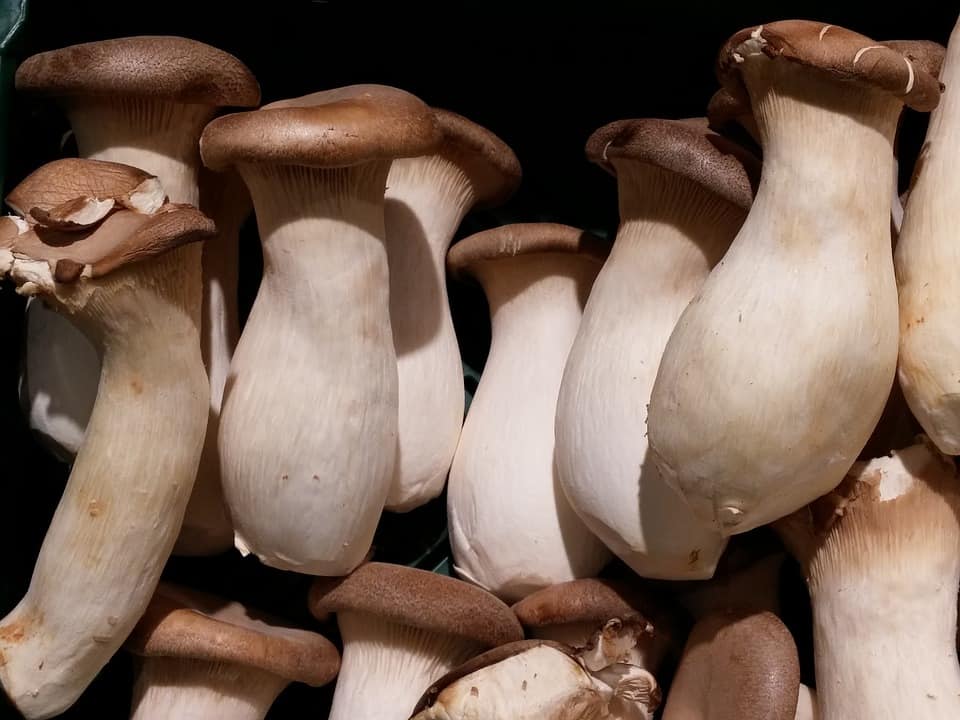
An aptly named meaty cousin of the common oyster mushroom, the king oyster grows upward with a thick, meaty stalk and a relatively narrow cap. The flavor is very similar to the tree oyster, but with a firm texture ideal for grilling or frying in large slices.
Although native to the Mediterranean region, king oyster mushrooms thrive in cool temperatures, naturally popping up in the fall. Because of this, the hardest part about growing king oysters is getting them to produce mushrooms from your kit block. They require cool temperatures to trigger pin (baby mushroom) formation.
King Oyster Mushroom Grow Tips: Given the king oyster’s temperature finickiness, growers prefer growing them in the fall and winter, using the natural cool temperatures outside or in their garage to induce fruiting. You can also try putting your king oyster block in front of an air conditioning unit or keep it in the refrigerator for a couple days. However, for the serious home grower, the ideal solution is using an old fridge,mini fridge, or even an old freezer with a third-party temperature controller, set at 50°F (10°C). Once you see baby mushrooms, you can raise the temperature by a few degrees.
Golden Oyster Mushroom
Brilliant yellow clusters of mushrooms that develops a nutty flavor when cooked
Species Name: Pleurotus citrinopileatus
Other Common Names: Yellow Oyster, Tamogitake
Flavor/Texture: Strong, nutty flavor when well-cooked; very delicate texture
Growing Media: Hardwood (logs, sawdust, chips), straw, coffee grounds, grains
Where to Grow: Outdoors (temperate/warm climate) or indoors
Fruiting Temperature: 70-85°F (21-29°C)
Growing Difficulty: Very Easy
Biggest Challenge: Balancing humidity and fresh air to get larger golden oyster mushrooms
Where to Get Kits/Spawn: Park Seed (US), North Spore (US), Suttons (UK), Grow Mushrooms Canada (Canada), Amazon (US, Can)
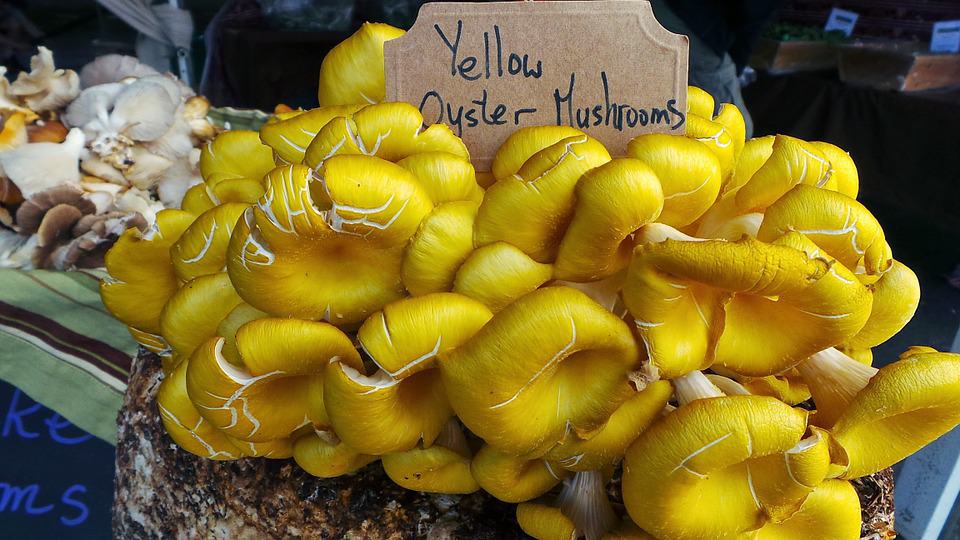
If you can’t grow cool-weather mushrooms, the golden oyster is a heat-loving species distinct from other members of the oyster mushroom family. Golden oysters prefer regular room temperatures and will grow rapidly as you get to around 80°F (27°C). However, the total harvested yield seems to be less than the more common tree oyster.
Although some people like eating undercooked or raw mushrooms, for golden oysters, their flavor can be quite bitter unless cooked well. Once cooked, they have a very unique, nutty flavor, almost like cashews. Note that the bright yellow color fades as you cook them.
Golden Oyster Mushroom Grow Tips: Aside from the unique taste, people like growing golden oysters for their bright yellow color. The intensity of that golden color depends on how much light they’re getting. Growing them out in the sun or growing indoors with a full-spectrum grow light will cause your mushrooms to look golden and vibrant.
Pink Oyster Mushroom
A prolific, bright pink mushroom that you’ll either love or hate to eat
Species Name: Pleurotus djamor
Other Common Names: Salmon Oyster, Flamingo Mushroom, Strawberry Oyster
Flavor/Texture: Savory, mushroomy, slight seafood flavor; small mushrooms are delicate while larger ones have a chewy texture
Growing Media: Hardwood (logs, sawdust, chips), straw, coffee grounds, grains, sugarcane fibers
Where to Grow: Outdoors (temperate/warm climate) or indoors
Fruiting Temperature: 70-85°F (20-30°C)
Growing Difficulty: Very Easy
Biggest Challenge: Balancing humidity and fresh air to get larger pink oyster mushrooms
Where to Get Kits/Spawn: North Spore (US), Merryhill Mushrooms (UK), Mycocultures (Canada), Amazon (US, UK)
Another warm-weather oyster mushroom, the pink oyster has a very delicate, savory flavor reminiscent of seafood. The texture is entirely dependent on the size of the pink oyster mushroom, with smaller ones being more delicate and larger ones being more chewy and meaty.
As beautiful as this mushroom is, people either love or hate the taste. The inconsistent texture and the slight seafood taste are a deal-breaker for some. But it’s very easy to take care of for the home grower and isn’t so finicky about growing conditions.
Pink Oyster Mushroom Grow Tips: Pink oyster mushrooms are best picked when young, right when the cap opens up. They also have a very short shelf life, spoiling in less than a week after harvest, so store your harvest in the fridge in a breathable bag for a few days at the most before cooking. Similar to golden oysters, pink oysters have a more vivid pink color when grown in high light conditions.
Shiitake Mushroom
The king of umami; meaty, extremely flavorful mushrooms
Species Name: Lentinula edodes
Other Common Names: Sawtooth Oak Mushroom, Black Forest Mushroom
Flavor/Texture: Strong mushroomy, savory/umami flavor; meaty texture
Growing Media: Hardwood (logs, sawdust, chips)
Where to Grow: Outdoors (temperate climate) or indoors
Fruiting Temperature: 50-70°F (16-18°C); there are some heat-tolerant strains that thrive in warmer temperatures
Growing Difficulty: Easy
Biggest Challenge: Successfully triggering fruiting after a growing block or log is fully colonized
Where to Get Kits/Spawn: Field & Forest (US), Cascadia Mushrooms (US), Mycoterra Farm (US), Merryhill Mushrooms (UK), Suttons (UK), Gourmet Woodland Mushrooms (UK; log spawn), Grow Mushrooms Canada (Canada; log spawn), Mycocultures (Canada), Amazon (US, UK, Can)
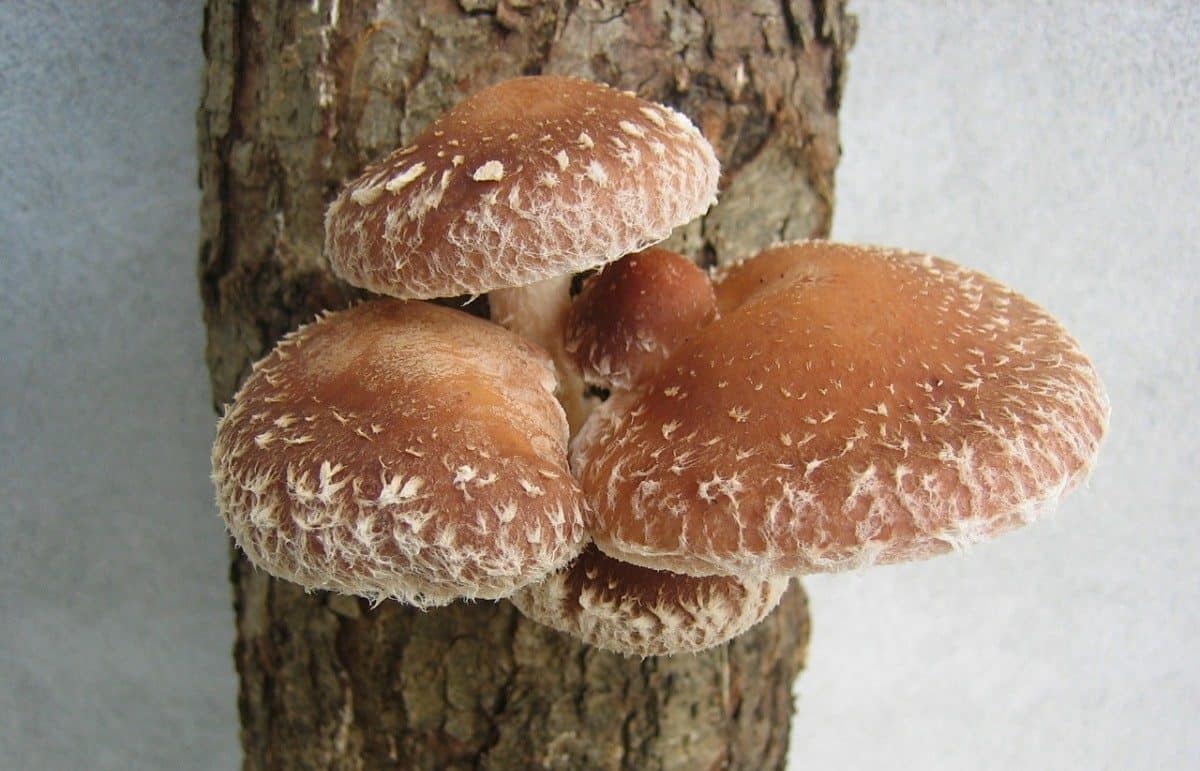
Shiitake mushrooms have rapidly become a commonly available mushroom in mainstream grocery stores and for good reason. They’re a meatier, more savory alternative to the common white/brown mushrooms sold everywhere. They’re also easier to grow at home.
Most kits you will find are made of sawdust, grains, or some combination of those, plus some nutritional amendments like soybean or rice hulls. These types of shiitake kits will usually give you your first harvest in a few weeks. However, shiitakes are also really easy to grow in logs if you don’t mind waiting longer for harvests. Log cultivation involves driving small wooden plugs inoculated with shiitake into hardwood logs and letting it naturally spread throughout the log, giving you smaller but consistent harvests for years.
Shiitake Mushroom Grow Tips: Getting shiitake to fruit can be tricky, but is not that hard for beginners. The first time I grew shiitake mushrooms from a kit, I saw nothing happening for over a month even though it was “ready to grow” and I had already soaked it and chilled it according to the instructions. If this happens to you, too, you can try this. Let your shiitake block almost completely dry out. Then, poke some holes in it with a knife to help the rehydration process, and resoak it in ice cold filtered water for 24-36 hours. I think I ended up going a little over 30 hours. If you don’t have filtered water you can fill a bucket with tap water and let it stand for a day or two beforehand so most of the chlorine can dissipate. Afterwards, I rinsed the block, gave it a good firm slap (without breaking it) and popped it in the fridge overnight wrapped in a plastic bag so it wouldn’t dry out. Then I took it out and followed the fruiting instructions with my kit (i.e. keeping it in a humidity tent and misting it with water a few times a day. Within a week I started seeing baby mushrooms, and not even a week after that I was picking my first shiitake mushrooms.
Wine Cap Mushroom
The easiest mushroom to grow outdoors, yielding large, succulent mushrooms with a complex flavor profile
Species Name: Stropharia rugosoannulata
Other Common Names: King Stropharia, Garden Giant, Burgundy Mushroom
Flavor/Texture: Strong mushroomy flavor with slight potato and red wine notes; meaty texture
Growing Media: Hardwood (chips), straw, compost with plenty of woody plant matter
Where to Grow: Outdoors (temperate climate) or indoors; best/easiest results outdoors
Fruiting Temperature: 60-70°F (16-21°C)
Growing Difficulty: Very Easy
Biggest Challenge: Getting spawn established outside and later harvesting the mushrooms before the cap opens up (best flavor)
Where to Get Spawn: Field & Forest (US), Mushroom Mountain (US), Asheville Fungi (US), Gourmet Woodland Mushrooms (UK), Grow Mushrooms Canada (Canada)
Wine cap mushrooms are the only mushroom here that seems to grow best outdoors, and are also incredibly easy to grow, almost requiring a hands-off approach once they get established in your garden.
Wine caps are large, meaty mushrooms with deep burgundy caps, like they’ve been stained with red wine. They also have subtle red wine notes when cooked. Wine cap mushrooms can adapt to almost any garden, as long as it’s not too hot and dry. And because the mycelium grows under layers of insulating mulch, it can survive easily in northern temperate climates.
Wine Cap Mushroom Grow Tips: I’ve already covered a lot about growing wine cap mushrooms in the garden, but in a nutshell, you should pick a partially shady bed in your garden, heavily mulched with preferably hardwood chips, and layer your Stropharia spawn between two layers of mulch. Water in well and keep moist until your wine caps get established. Refresh your bed with new mulch every year and you will keep getting wine cap mushrooms for years.
Lion’s Mane Mushroom
A unique white mushroom that has a subtle crab or lobster taste and texture
Species Name: Hericium erinaceus
Other Common Names: Monkey Head Mushroom, Bearded Tooth Mushroom, Pom Pom Mushroom
Flavor/Texture: Subtle mushroomy flavor with crabmeat notes; meaty, shellfish texture when cooked
Growing Media: Hardwood (logs, sawdust, chips)
Where to Grow: Outdoors (temperate climate) or indoors
Fruiting Temperature: 65-75°F (18-24°C); requires slightly cooler temperatures to trigger fruiting, but there are some heat tolerant strains
Growing Difficulty: Easy to Moderate
Biggest Challenge: Balancing high humidity and air flow to produce large, full heads of Lion’s Mane
Where to Get Kits/Spawn: North Spore (US), Mycoterra Farm (US), Cascadia Mushrooms (US), Upcycled Mushrooms (UK), Gourmet Woodland Mushrooms (UK; plug spawn only), Isle of Wight Mushrooms (UK), Grow Mushrooms Canada (Canada), WhatTheFungus (Canada), Happy Caps (Canada)
One of the most unique-looking wood-loving mushrooms is the lion’s mane. If you’ve heard of it before, it’s likely because of the health benefits. Apparently, it’s also sold in some grocery stores but I still haven’t seen any in my area, so the first lion’s mane I ever had was one I grew myself.
The mushroom grows like a giant puffball with long “teeth” hanging down, like a pom pom (which is another name it goes by). The teeth are soft like the rest of the lion’s mane. Taste-wise, lion’s mane has a very mild, subtle mushroom taste, with notes of crab or lobster. When sliced and cooked, it even kind of breaks apart like crabmeat, too. If you don’t like strong mushroom flavors, give the lion’s mane a try.
Lion’s mane does require cool temperatures to induce fruiting, but it’s not as picky as king oyster. I’ve fruited lion’s mane at room temperature.
Lion’s Mane Mushroom Grow Tips: The most common problem people have growing lion’s mane is getting enough fresh air flow to promote full growth of the “teeth” that hang down while also keeping humidity high so the mushroom actually grows to a full size. This is really tricky with just a grow tent. One approach is to fruit it in a “shotgun fruiting chamber” (SGFC) which is a large tub with holes all over it to allow free air flow and a layer of moist perlite to keep the humidity up. Freshcap Mushrooms has an easy guide on building a SGFC. However, even if your lion’s mane looks more like a cauliflower than a mane, it’s still perfectly edible and will taste the same.
Beech Mushroom
Ordinary mushrooms with extraordinary taste and prolific production
Species Name: Hypsizygus tessellatus
Other Common Names: Shimeji Mushroom, Brown/White Clamshell Mushroom
Flavor/Texture: Slightly sweet and nutty flavor; crisp and firm texture
Growing Media: Hardwood (logs, sawdust, chips)
Where to Grow: Outdoors (temperate climate) or indoors
Fruiting Temperature: 55-65°F (13-18°C)
Growing Difficulty: Easy (kit) to Moderate (from spawn)
Biggest Challenge: Beech mushrooms grow more slowly and may require additional care to avoid contamination, unless using a ready-to-grow kit
Where to Get Kits/Spawn: Midwest Grow Kits (US), North Spore (US; spawn only), Sharondale Farm (US; spawn only), Mushroom Kits Canada (Canada)
Beech mushrooms are still mostly under the radar but if you’re lucky to have them in your grocery store (they may be sold as shimeji or clamshell mushrooms), they’re a really unique treat. Coming in either brown or white caps, beech mushrooms look like ordinary mushrooms, but have a slightly sweet and nutty flavor when cooked, with a firm texture.
These mushrooms grow in large, prolific clusters and are relatively easy to grow in kits. However, because their mycelium grows more slowly, it can be more difficult to grow from spawn.
Beech Mushroom Grow Tips: Since beech mushrooms grow in large clumps, you can harvest the entire clump. You can use a knife to cut them right at the base and twist off the clump of mushrooms. If growing from spawn, take extra care to pasteurize or sterilize your growing medium well as it will take longer for the mycelium to colonize. Pro-tip: If your beech mushrooms taste bitter or astringent, they haven’t been cooked enough.
Enoki Mushroom
Long, skinny, pearly white mushrooms with a unique crisp mouthfeel; is eaten raw, slightly cooked, and fully cooked
Species Name: Flammulina velutipes
Other Common Names: Enokitake, Velvet Shank, Winter Mushroom
Flavor/Texture: Very mild mushroomy flavor; crisp, “al dente” texture
Growing Media: Hardwood (sawdust preferred)
Where to Grow: Outdoors (temperate/cool climate) or indoors
Fruiting Temperature: 50-60°F (10-16°C); requires colder temperatures to induce fruiting
Growing Difficulty: Moderate to Hard
Biggest Challenge: Temperature requirements make this mushroom variety tricky to fruit, and getting long, skinny, white enoki requires additional techniques; kits strongly recommended for beginners
Where to Get Kits/Spawn: True Leaf Market (US), Mycocultures (Canada)
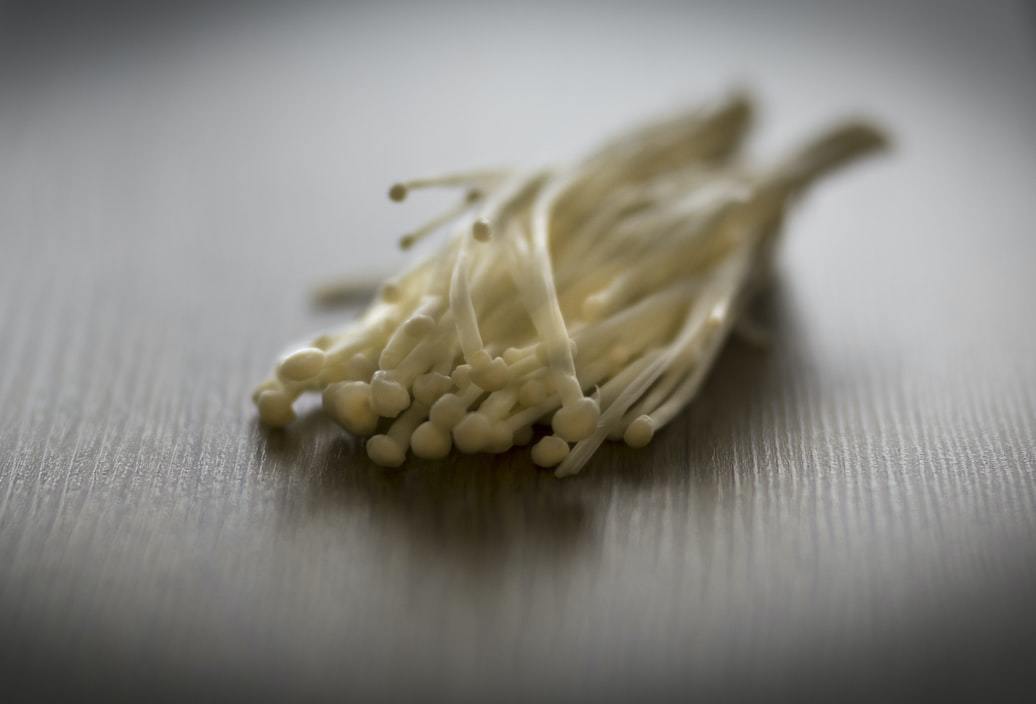
Enoki mushrooms are a versatile, unique mushroom that can be grown at home, although it’s not for beginners. They have a very subtle taste, but are eaten more for the texture, which is crisp when raw and more of an “al dente” noodle texture when cooked.
The cool thing about enoki mushrooms is that in the wild they look nothing like the enoki mushrooms you buy at the grocery store. In nature, they have more of a natural, stumpy mushroom shape, with more red, brown, or orange coloration. But because of how they are cultivated in mushroom farms (check out the tips below) they end up growing long, skinny stems and are almost completely white.
Enoki mushrooms are not just for soups! You can stir-fry them or add them raw to salads. The late, great Italian chef Antonio Carluccio was a notable mushroom lover and one of his recommended ways of serving enoki mushrooms was as a small bunch wrapped in a slice of prosciutto and drizzled with some lemon and olive oil. If you prefer your enoki mushrooms cooked, try wrapping them in bacon for a rich treat.
Enoki Mushroom Grow Tips: You can utilize the same strategies to initiate fruiting as with king oyster mushrooms. To grow white enoki mushrooms, you should grow them in the dark, which will ensure they won’t develop any color. To get long, noodle-like enoki mushrooms with tiny caps, you will need to increase the amount of carbon dioxide in the environment. The way professional enoki mushroom farmers do this is by putting a plastic shield or cone around the top of the growing medium (usually large bottles filled with sawdust and supplements) to build up CO2 levels. This works because mushrooms breathe in oxygen and release CO2 just like animals, and CO2 is heavier than oxygen. Below is a cool video showing this in an enoki mushroom farm. Note the shields around the top of the bottles.

